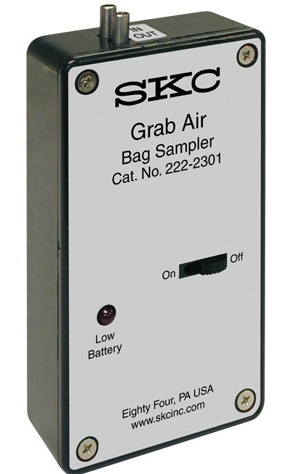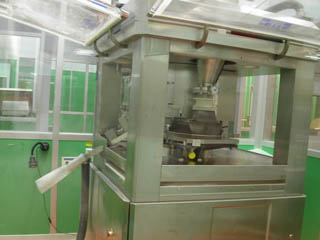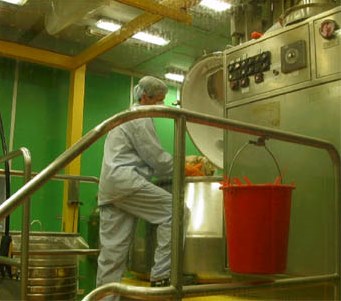When and for how long?
How long should I sample for?
It is very important that you take your samples at the right time, in the right place and for an appropriate period.
This is because the airborne concentrations of contaminants will vary considerably with both location and time. You need to bear this variation in mind when deciding on:
- When you take the samples and
- The length of the sampling period.
There are three main options when deciding length of the sampling period:
- Instantaneous (grab samples)
- Integrated samples
- Continuous samples.
Instantaneous (grab samples)
Some sampling instruments can give a true instantaneous reading of the concentration of contaminants. In other cases we can take a grab sample over a short period (a few seconds or minutes), for example, colorimetric tubes. The nature of the equipment used means that in most cases it is only possible to take static, rather than personal, samples.

Image source: http://www.skcltd.com/
Integrated samples
Here a sample is taken over a longer time and the result represents the average concentration over the sampling period. Both personal and static samples can be taken.
Continuous samples
In addition to short term and integrated sampling, concentrations can be continuously monitored. A continuous monitoring sampling device gives a direct reading of the concentration and also stores the information on the instrument, which can be downloaded. This type of sample is useful to show how the concentration varies, for example, when trying to find out which stage of a process is associated with the highest concentration.
The size of this equipment means that it is normally only possible to carry out static sampling, although some smaller devices are available for some types of contaminant that can be attached to the worker.

Sample duration
When sampling worker exposure, the decision on sample duration largely depends on the type of exposure limit you plan to compare your result with.
There are two main types of limit: short-term and long-term.
Short term limits - average exposure during short periods (15 minutes).
- With short-term limits, the main problem is ensuring the sample is collected at the right time.
- Normally, we will want to collect the sample when we expect exposure will be at its highest level.
- Therefore, we will need to make observations and fully understand the process to help us to decide the peak concentrations of the contaminant are likely to occur.

Image courtesy of author
Long term limits - average exposure during a full shift (8 hours).
- When a substance has a long-term limit, ideally the samples should be taken over a full work shift.
- When the operation does not take the full shift to complete, the average exposure during the shift can normally be calculated by knowing the worker’s exposure during the remainder of the shift.
- If that information is not available it may be necessary to sample during periods when no obvious exposure is taking place (to ensure background concentrations are negligible).
Example scenarios
Scenario 1
A worker moves from room to room loading powders into blenders. He performs this task continuously over his 8-hour shift.
What duration of sample would you collect in this situation?

Image courtesy of author
If the contaminants have long-term exposure limits and his task is performed over the entire shift, it would be best to take sample for the full duration of the shift.
Scenario 2
A drum containing toluene has been knocked over by a lift truck and about 200 litres have been spilled on the floor of a production area. Once the material is cleaned up, workers will need to know it is safe to re-enter the area.
What duration of sample would you collect in this situation?

Image source: http://www.chemocart.com
We need a quick answer, so a grab sample would be most appropriate. The person collecting the sample would need to take precautions during sampling. The information from the grab sample can then be used to decide on what precautions are needed while the spillage is cleared up. It would also be sensible to take a further sample to check the concentration before the area was re-occupied.
Scenario 3
Two workers are about to enter a chemical storage tank to carry out an internal inspection. The tank has been drained and previously contained a volatile solvent.
What duration of sample would you collect in this situation?

Image courtesy of author
In this case, we would need to collect a grab sample check the concentration of the vapour (and the oxygen level) before entry. We may also want to carry out continuous sampling for the vapour while the workers are inside the tank.
Scenario 4
Workers operate a process where they can be exposed to a dust that has both long term and short term effects. It has a long-term limit of 1 mg/m³ and a short-term exposure limit of 2.5 mg/m³. At the end of the shift, they have to clean out the equipment, which typically takes between 15 and 25 minutes. You have noticed that during cleaning the workers put their heads inside the machines and that a dust cloud is generated.
What duration of sample would you collect in this situation?
In this case, the best approach would probably to take a sample covering the majority of the shift with a separate 15-minute sample during the cleaning operation. The 15-minute sample would allow us to check whether the short-term limit has been exceeded during this task. A quick calculation using the results from both samples would allow us to check compliance with the long-term limit.
